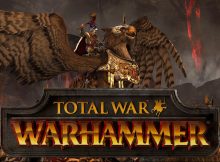Feel the Old World of Warhammer come to life in this beautifully crafted RTS
With the newly released Total War: Warhammer 2, it’s time to look back to its predecessor and see what made it one of the most successful titles in the Total War game series. Developed by Creative Assembly, previous Total War game titles were all based on historical events, such as the Roman empire and Napoleonic Wars, for example. Consequently, the two latest Total War titles feel like a breath of fresh air, taking on the fantasy world of Warhammer.
In Total War: Warhammer’s campaign, the player takes control of one of the many different factions inhabiting the Old World. In the base game, four races are available, and several new factions have since been made available to play via DLC. The player manages the empire of his or her chosen faction by building settlements, raising armies and making alliances. This is achieved in a turn-based campaign overview, where each faction moves their armies around the campaign map, claiming territory and initiating diplomacy. When two armies at war with each other meet on the campaign map, they proceed to fight each other in a real-time strategy battle.
The beautiful thing about Total War: Warhammer is the diversity of its factions: each race feels very distinct to each other. All factions have their own strengths and weaknesses in battle: the Dwarf armies being tough to break but lacking mobility, while the Wood Elves are very nimble but fragile in sustained combat, for example. The different mechanics between factions is not just apparent on the battlefield, but they also work very distinctly on the campaign map. For example, while most armies build settlements around the Old World map, the Chaos faction is unable to do so, it’s armies swooping from the northern Chaos Wastes, gaining strength from the chaos (no pun intended) they sow on the campaign map, corrupting the land with their daemonic taint. Creative Assembly clearly pays tribute to the source material, the essence of each race being captured in the gameplay. This gives the game a very healthy amount of replayability, as the different factions offer very different play experiences.
The only real criticism the game deserves is the way its DLC was handled: the most atrocious examples featuring a separate paid DLC for blood and gore effects, despite the brutality of the Warhammer world being one of its staples. In addition, the choice to feature Chaos, one of the core factions of the lore, as first a pre-order bonus faction and later as paid DLC, was a very questionable one.
All in all, Total War: Warhammer managed to bring the audience of two franchises together: for Total War fans, this title offered a refreshing take on the historic settings of the previous titles. As for Warhammer fans, the game is a quality strategy game that encapsulates the violent world of Warhammer faithfully.
Developer: Creative Assembly
Publisher: SEGA
Platform: Microsoft Windows, Linux, MacOS
Release date: 24.5.2016
Genres: Turn-based strategy, real-time tactics


